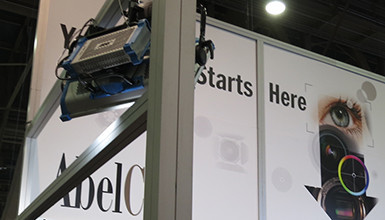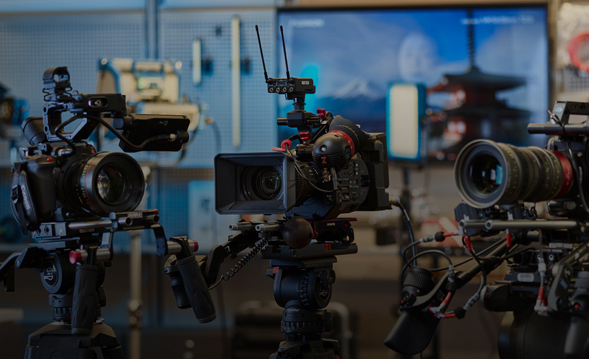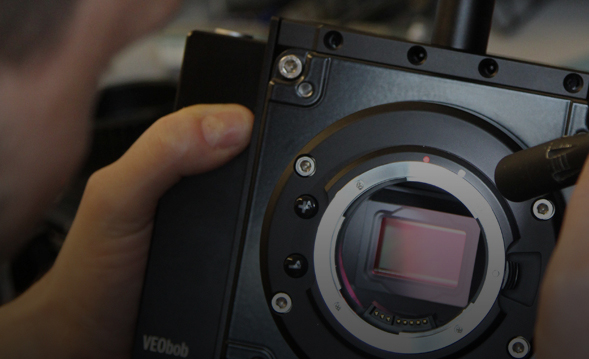Overview
The Steadicam Steadimate 15 Support System includes: a Steadicam Vest + Steadicam Arm (supports up to 15lb capacity) + Steadimate Adapter to pair with your existing motorized gimbal.
The Steadicam Steadimate allows operators to attach The Steadicam Arm and Vest to motorized gimbal stabilizers, including the DJI Ronin and Freefly MōVI. Simply swap out one of the handles of your motorized gimbal and replace it with the Steadimate. From there, the Steadimate serves as the handle of your motorized gimbal, but now advantageously equipped with an arm post for attaching a stabilizing arm.
The Steadicam Arm isolates the operator's movement from the camera while the Vest and Arm reduce fatigue. The Steadimate will connect your motorized gimbal and provide fingertip control of its movements. Pair this system with a remote controller (sold separately) so one camera operator can concentrating on framing and footing while the other navigates the focus/iris/zoom adjustments.
Major benefits to placing an arm and vest on a motorized gimbal:
- Longer duration of handheld recording
- Adapting your motorized gimbal with an arm and vest turns your motorized gimbal into a body-worn stabilizer, meaning the operating load is taken off the arms of the operator. This allows for longer durations of operation.
- Increased footage stability since The Arm isolates the camera operator movement from what is recorded.
- Increased stability in footage; the Steadimate Adapter provides tilt axis stabilization, as well as z-axis stabilization from the Steadicam Arm.
Steadicam Steadimate Adapter
The Steadicam Steadimate Adapter is a device to help you pair your existing Steadicam vest and arm with a motorized gimbal stabilizer such as the DJI Ronin or a Freefly MoVI. Simply swap out one of the handles of your motorized gimbal mount and replace it with the Steadimate. From there, the Steadimate serves as the handle of your motorized gimbal, but now advantageously equipped with an arm post for attaching a stabilizing arm. The Steadimate links your Steadicam Arm to the motorized gimbal and allows fingertip control.
Compatibility
The Steadimate gimbal mount comes standard with a post block and balance pin that fit arms with 1⁄2" posts. Accessories are available separately which adapt the Steadimate to fit arms with 5/8" and 3⁄4" posts.
The weight capacity for the Steadimate depends on the weight capacity of the motorized gimbal, arm, and vest used. For operators who already own an arm and vest, the Steadimate can be purchased on its own.
For operators in need of a complete kit, Tiffen offers Steadimate Systems in two weight classes (sold separately):
- Steadimate 15 System with the A-15 Arm & Vest [15 lb / 6.8 kg capacity]
- Steadimate 30 System with the A-30 Arm & Vest [30 lb / 13.6 kg capacity]
How it Works
Attach the Steadimate adapter to the handlebar of the motorized gimbal
Balance the Steadimate System
Connect your existing Steadicam Arm (which supports the Steadimate System and isolates camera from operator) and Vest (which is adjustable to fit more operators and provides connection to the Arm)
What it Offers
- Remove the load off the operator's arms to reduce fatigue. Steadicam Arm and Vest bears the weight on your body instead of your arms.
- Effortless tilting via the pivot on the Steadimate.
- Increased stability & z-axis stabilization for the smoothest shot possible.
- Quick interchangeable use from handheld operation to Steadimate operation.
- Position your motorized gimbal in Upright or Inverted mode.
NOTE: You can still use your motorized gimbal in a traditional manner. There is no need to replace the original handgrip or rebalance.
Steadimate Components
The Steadimate is made up of a number of clamps, posts, balance weights, and locks. A handy graphic is available in our photos to help you identify the components. Your motorized gimbal will attach to the Steadimate with a Handlebar Clamp. You can adjust the alignment using the Tilt Balance Mechanism and Tilt Balance Lock Screw. A Post Block exists to connect the Steadimate to your Steadicam Arm. Included Balance Weights on the bottom of the Post help fine tune the counterbalance.
NOTE: Proper setup of your motorized gimbal is critical to accurately balancing the Steadimate System. Refer to the manual from your motorized gimbal manufacturer for directions on properly tuning their device. Remember to blanace the Steadimate System with the motorized gimbal powered on.
Moving with the Steadimate & Your Steadicam Vest/Arm
Stand up straight whenever possible so you can let the Steadicam Vest, Arm, and Steadimate do all the work. Steadicam suggests you maintain most of your weight on one foot so you can move in any direction at any time.
Similar to traditional Steadicam operating, start and finish every move with your arm. Simply move the Steadimate System in the direction you wish to travel, then follow along with your feet.
Always use a spotter when walking backwards to keep you safe.
Extend your range of movement by sitting, kneeling, or stepping up onto objects like apple boxes, curbs, steps, etc.
Should you decide to use a dolly or other form of moving vehicle, please take caution to protect you and your equipment.
Be careful where you place your fingers so they will not be pinched when you raise the arm.
You can also achieve both Upright and Inverted Modes with your motorized gimbal and the Steadimate. When the Steadimate remains upright (within 0-45° of vertical), you will be balancing in Upright Mode. If the Steadimate is more than 45° from vertical, you will be balancing your rig in Inverted Mode. Be sure to read up on how to balance and center your Steadimate using Steadicam's appropriate product manual or you can attend one of AbelCine's Steadicam training classes across the nation.
The Solo Vest
The lightweight Solo Vest features a payload capacity of up to 10lb (approx. 4.5 kg). This is the thinnest and lightest vest which Steadicam offers. You can wear it under a tuxedo jacket, if you need your camera operator to fit into a crowd scene. The vest itself weighs about 2.6 lb (approx. 1.178 kg) and fits to your torso with hook and loop straps for a wide range of body size adjustability. It also features nylon buckles for quick access and removal.
Vest Sizing Choice for Operators:
- Weight Under 100lbs / Height up to 4'6"
- Weight Over 100lbs / Height over 4'6"
The Steadicam Arm
The Steadicam Arm supports the weight of the Steadimate System while helping isolate the camera from the operator's movements. In that way, you footage does not reflect uneven ground or the slight bouncing/jostle which occurs when someone shoots handheld footage without stabilization. The Arm facilitates booming the camera up and down. The lifting strength of The Arm is adjustable to accommodate a wide range in payload. It also incorporates side-to-side adjustment wheels which help align the lifting axis to your body.
The Arm includes: an Arm Post which connects to the Post Block (where your camera sits or where the Steadimate will interface with the Steadicam Arm), springs in the forearm and upper arm sections, a double action hinge (where the elbow would be, if this was your body), and two lift adjustment knobs which are only adjustable under load. The socket arm (which connects to your Steadicam Vest via the Socket Block on The Vest), features a socket quick release pin and side-to-side adjustment wheels to align The Arm to your body.
IMPORTANT NOTE: Remember to keep a hand on the end of The Arm as you connect it to your vest. Otherwise, The Arm might swing out or even in to accidently injure someone or somthing around you, or to impact against your body or face.
Using the System
Steadicam and AbelCine recommend you learn how to use a Steadicam System via a hands-on course. If you aren't ready for that and are just wondering how the system functions with you in it, there are a number of video blogs available for you to view on the Steadicam in action.
Remember that you will put on your Vest (after adjusting it properly), then connect The Arm, then approach your motorized gimbal (which should be resting on an appropriate docking stand with the camera already in place and balanced). You would simply bend forward to place the Arm Post into the receiver on the Post Block.Please remember to bend at the hips for this maneuver. You may find that raising your gimbal camera rig on the dock so that the handlebar (or in this case the Steadimate) above your motorized gimbal is roughly at chin level is a more comfortable position to make the proper connection.
At this point, you should step forward so that The Arm takes the weight of the motorized gimbal and compresses the connection fully. Now you can lift the unit from the docking stand and step backwards. Make sure to do all of this in a non-crowded area, if possible, to prevent accidental collisions.
Steadimate Operating
The Steadicam System with the Steadimate and your motorized gimbal, camera, and lens are now capable of helping you create organic, dynamic moving footage all day long. Fingertip control is not just boasting points with this rig, you really can use light control to create tilt and pan movement of your camera.
Remember, like any Steadicam, to let The Arm and the Steadicam Vest do all the work for you. Be ready to move in any direction by placing your full weight on one foot. You will start and end each move with The Arm. Move the Steadimate in the direction of travel, then follow with your feet. There is no need to lean since you can tilt the camera and adjust vertical position with your arms.
Always ensure that you have a spotter in place when moving backwards with all that expensive gear. Ask an appropriate person to guide you with a hand on your vest for that perfect shot your Director wants.
NOTE: Be sure you do not place your hand or fingers inside The Arm mechanism or it might bite.
Specifications
Key Highlights
- 15lb payload capacity
- Lightest vest Steadicam offers
- Smooth shots & less work for an operator
- Steadimate links Arm to motorized gimbal
- Gimbal with 25/25.5/30mm dia. handle
- Fits arms using a 1/2" post
- Pair with Freefly MoVI or DJI Ronin























